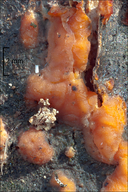|
|
click photo for larger file

Nectriaceae sp.
|
Photographer: Dr. Amadej Trnkoczy
ID: 0000 0000 1114 1185 (2014-11-08)Copyright © 2014 Dr. Amadej Trnkoczy
|
|
INFORMATION PROVIDED WITH THE PHOTO
|
date of photo Feb 27, 2014
latitude 46.34043 longitude 13.55264
View on Google Maps.
location
Bovec basin, north outskirts of Bovec, near 'Žaršče' place, East Julian Alps (Posočje, Slovenia)notes Habitat: ruderal ground, wood edge near town outskirts, almost flat terrain, open and sunny place, exposed to direct rain, average precipitations ~ 3.000 mm/year, average temperature 8-10 deg C, elevation 480 m (1.580 feet), alpine phytogeographical region. - Substratum: on bark of live Robinia pseudacacia branch. - Comments: This small, orange, jelly blobs superficially appeared to me somewhat similar to Dacrymyces or Exidia species. But, very long and narrow, septated 'spores' and absence of fork like or longitudinally septated basidia, respectively, exclude these options. I was unable to find anything, which I could recognize as either basidia or asci. Hence I was speculating this observation could eventually be an anamorph of an ascomycete or a hyphomycete. Without experience with them I had no clue what it is. Also numerous spherocarps (see Figs. 5, 7, and 9) and large crystals in the context (Fig.:10) were (and still are) a secret to me. - Fortunately Mr. Neven Matočac (Ref.:1) was kind enough to teach me that determination to species level of such finds requires much more than pictures and a little bit of microscopy. In vivo studies, using cultures, and DNA analyses are in most cases required for any certainty level of determination. His very brief and tentative opinion was that the pictures probably show an anamorph of a member of Nectriaceae family, eventually from genera Haematonectria or Gibberella, while the macroconidia resembles to genus Fusarium. - Orange blobs were growing on and through the bark in an area of about 4 x 1 cm; SP was barely noticeable, probably whitish, but spores under the microscope were abundant. - Spores smooth. Dimensions: 28.9 [43.6 ; 50.1] 64.8 x 3.4 [3.9 ; 4.2] 4.8 microns, Q = 7.3 [10.8 ; 12.3] 15.8; N = 31; C = 95%; Me = 46.9 x 4.1 microns. Hypha is thin walled, of varying diameter from 3 to 9 microns. Olympus CH20, NEA 40x/0.65, magnification 400x, in water, congo red. AmScope MA500 digital camera. - Herbarium: Mycotheca and lichen herbarium (LJU-Li) of Slovenian Forestry Institute, Večna pot 2, Ljubljana, Index Herbariorum LJF - Ref.: (1) Personal communication with Dr. Neven Matočec, Division for Marine and Environmental Research, Ruđer Bošković Institute, Zagreb, Croatia. (2) Leg.: Bojan Rot. (3) H. Dӧrfelt, E. Ruske, Die Welt der Pilze, Weissdorn-Verlag, Jena (2008), p 172.camera Nikon D700/Nikkor Micro 105mm/f2.8
contributor's ID # Bot_786/2014_DSC0137 photo category: Fungi - fungi
|
MORE INFORMATION ABOUT THIS FUNGUS
|
| View all photos in CalPhotos of Nectriaceae sp. Check Google Images for Nectriaceae sp. |
|
The photographer's identification Nectriaceae sp. has not been reviewed. Sign in to review or comment on this photo |
|
Using this photo The thumbnail photo (128x192 pixels) on this page may be freely used for personal or academic purposes without prior permission under the Fair Use provisions of US copyright law as long as the photo is clearly credited with © 2014 Dr. Amadej Trnkoczy.
For other uses, or if you have questions, contact Dr. Amadej Trnkoczy amadej.trnkoczy[AT]siol.net. (Replace the [AT] with the @ symbol before sending an email.) |
|
|
